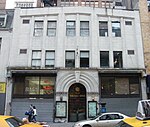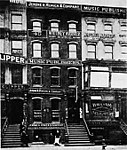Tin Pan Alley was a collection of music publishers and songwriters in New York City which dominated the popular music of the United States in the late 19th and early 20th centuries. It originally referred to a specific place: West 28th Street between Fifth and Sixth Avenues in the Flower District of Manhattan; a plaque (see below) on the sidewalk on 28th Street between Broadway and Sixth commemorates it.In 2019, the New York City Landmarks Preservation Commission took up the question of preserving five buildings on the north side of the street as a Tin Pan Alley Historic District. The agency designated five buildings (47–55 West 28th Street) individual landmarks on December 10, 2019, after a concerted effort by the "Save Tin Pan Alley" initiative of the 29th Street Neighborhood Association. Following successful protection of these landmarks, project director George Calderaro and other proponents formed the Tin Pan Alley American Popular Music Project to continue and commemorate the legacy of Tin Pan Alley with various advocacy and educational activities.
On April 2, 2022, 28th Street between Broadway and 6th Avenue was officially co-named “Tin Pan Alley” by the City of New York in a celebration featuring NYC City Councilmember Erik Bottcher, Manhattan Borough President Mark Levine and representatives from the NYC Landmarks Preservation Commission, the Flatiron/23rd Street Partnership and the Tin Pan Alley American Popular Music Project which advocated for the co-naming.
The start of Tin Pan Alley is usually dated to about 1885, when a number of music publishers set up shop in the same district of Manhattan. The end of Tin Pan Alley is less clear cut. Some date it to the start of the Great Depression in the 1930s when the phonograph, radio, and motion pictures supplanted sheet music as the driving force of American popular music, while others consider Tin Pan Alley to have continued into the 1950s when earlier styles of music were upstaged by the rise of rock & roll, which was centered on the Brill Building. Brill Building songwriter Neil Sedaka described his employer as being a natural outgrowth of Tin Pan Alley, in that the older songwriters were still employed in Tin Pan Alley firms while younger songwriters such as Sedaka found work at the Brill Building.









